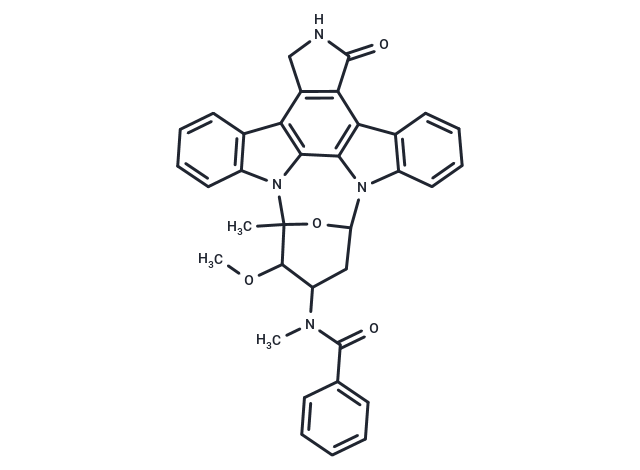Shopping Cart
- Remove All
 Your shopping cart is currently empty
Your shopping cart is currently empty

PKC412(Midostaurin (PKC412); CGP41231; CGP41251) is a broad spectrum protein kinase inhibitor. Midostaurin inhibits protein kinase C alpha (PKCalpha), vascular endothelial growth factor receptor 2 (VEGFR2), c-kit, platelet-derived growth factor receptor (PDGFR) and FMS-like tyrosine kinase 3 (FLT3) tyrosine kinases, which may result in disruption of the cell cycle, inhibition of proliferation, apoptosis, and inhibition of angiogenesis in susceptible tumors.

| Pack Size | Price | Availability | Quantity |
|---|---|---|---|
| 1 mg | $47 | In Stock | |
| 5 mg | $80 | In Stock | |
| 10 mg | $128 | In Stock | |
| 25 mg | $228 | In Stock | |
| 50 mg | $345 | In Stock | |
| 100 mg | $513 | In Stock | |
| 500 mg | $1,150 | In Stock | |
| 1 mL x 10 mM (in DMSO) | $97 | In Stock |
| Description | PKC412(Midostaurin (PKC412); CGP41231; CGP41251) is a broad spectrum protein kinase inhibitor. Midostaurin inhibits protein kinase C alpha (PKCalpha), vascular endothelial growth factor receptor 2 (VEGFR2), c-kit, platelet-derived growth factor receptor (PDGFR) and FMS-like tyrosine kinase 3 (FLT3) tyrosine kinases, which may result in disruption of the cell cycle, inhibition of proliferation, apoptosis, and inhibition of angiogenesis in susceptible tumors. |
| Targets&IC50 | PKCγ:24 nM, PKCα:22 nM, PKCβ2:31 nM, PKCβ1:30 nM, PPK:38 nM |
| In vitro | Midostaurin(pkc412) is a broad spectrum protein kinase inhibitor. Midostaurin(pkc412) interacts strongly with ATP binding sites of the conventional PKC-α, -β and -γ, PDGFRβ, VEGF-R2, VEGF-R1 and the cyclin-dependant kinase 1-cyclin B complex. Midostaurin(pkc412) inhibits the growth of various human and animal cell lines in vitro at similar submicromolar concentrations. Midostaurin(pkc412) also effectively inhibits the in vitro proliferation of glioblastoma and induced the accumulation of cells in G2/M and formation of giant nuclei with extensive fragmentation and apoptotic bodies. Midostaurin(pkc412) is able to reverse the p-glycoprotein-mediated multidrug resistance of tumor cells in vitro. [1] |
| In vivo | Midostaurin(pkc412) may suppress tumor growth by inhibiting tumor angiogenesis (via its effects on the VEGF receptor tyrosine kinases) in addition to directly inhibiting tumor cell proliferation (via its effects on PKCs). This anti-angiogenic action may contribute to the antimetastatic and broad antitumor activity displayed by midostaurin(pkc412), as well as the synergy with cytotoxic agents, including doxorubicin, cyclophosphamide, cisplatin and gemcitabine. When given orally, the maximally tolerated dose for midostaurin(pkc412) is >300 mg/kg. [1] |
| Kinase Assay | Cells are plated overnight and treated with 100 nM AZD3965 or vehicle for 24 hours. The cells are then washed, once in PBS and twice with lysis buffer (50 mM Mops, 100 mM KCl, 5 mM MgCl2, 1 mM EDTA, 0.1 mM DTT, 1 mM PMSF supplemented with 1× mini complete protease inhibitor cocktail tablets. The cells are harvested by scraping and centrifugation, and the pellet snap frozen without buffer in liquid nitrogen. Frozen aliquots of cells are thawed on ice and re-suspended in lysis buffer. Cells are lysed by 3 rounds of freezing in liquid nitrogen and thawing at 37°C for 2 minutes each. Lysates are subsequently centrifuged (13000 g, 10min, 4°C) until clear and then stored on ice. Enzyme activity in the cell lysates is determined using a micro-plate reader to measure either production or depletion of NADH/NADPH, through its absorbance at 340/10 nm, occurring as a result of direct or coupled enzyme reactions. The 96 well plates used for the assays are pre-heated to 37°C for 10 minutes prior to starting reactions, initiated by the addition of 5 μL cell lysate to 95 μL of reaction buffer (50 mM Mops pH 7.4, 100 mM KCl, 5 mM free magnesium). The standard reaction buffer is supplemented to assay the kinetics of the different enzymes. Absorbance values for controls are subtracted from absorbance of corresponding reactions. Graphpad prism 6 is used to plot V0 values against substrate concentration and determine Vmax and Km values. The Vmax is then normalised to the protein concentration in the cell lysate[1]. |
| Cell Research | Each well is added with 5 mM WST-1 and 0.2 mM 1-methoxy PMS and the absorbance at 450 nm is measured by a Microplate Reader.(Only for Reference) |
| Alias | PKC412, N-Benzoylstaurosporine, CGP41231, CGP 41251 |
| Molecular Weight | 570.64 |
| Formula | C35H30N4O4 |
| Cas No. | 120685-11-2 |
| Smiles | COC1C(CC2OC1(C)n1c3ccccc3c3c4CNC(=O)c4c4c5ccccc5n2c4c13)N(C)C(=O)c1ccccc1 |
| Relative Density. | 1.46g/cm3 |
| Storage | Powder: -20°C for 3 years | In solvent: -80°C for 1 year | Shipping with blue ice. | ||||||||||||||||||||||||||||||
| Solubility Information | DMSO: 55 mg/mL (96.38 mM), Sonication is recommended. | ||||||||||||||||||||||||||||||
Solution Preparation Table | |||||||||||||||||||||||||||||||
DMSO
| |||||||||||||||||||||||||||||||

Copyright © 2015-2025 TargetMol Chemicals Inc. All Rights Reserved.